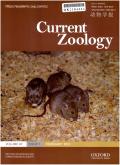Structural characteristics of the epidermis in marine and freshwater finless porpoises adapted to distinct osmotic environments
IF 2
2区 生物学
Q2 ZOOLOGY
引用次数: 0
Abstract
The Yangtze finless porpoise (Neophocaena asiaeorientalis asiaeorientalis, Pilleri & Gihr, 1972; YFP) is an exclusively freshwater cetacean species inhabiting the Yangtze River and its connecting large lakes. As the primary line of defense in maintaining physiological equilibrium, the epidermis of the porpoise is expected to have undergone structural adaptations due to the shift from the marine to the freshwater environment. This study compared the microstructural and ultrastructural features of the epidermis of YFP and its marine counterpart, the East Asian finless porpoise (Neophocaena asiaeorientalis sunameri, Pilleri & Gihr, 1975; EAFP). Microscopic structural observations and statistical analyses of the epidermal thickness demonstrated no significant differences in the cell structure or distribution between the two porpoise species. However, the epidermis of the YFP contained more abundant stratum basale cells. The outermost lipid stratum corneum exhibited a thinner cell layer with wider neutral lipid droplets to resist the passive entry of water molecules in the hypotonic environment. In contrast, for the EAFP, a more uniformly arranged stratum basale in the epidermis led to denser keratin fibers and robust desmosomes within each epidermal layer at the ultrastructural level. This tight arrangement of cells can reduce transepidermal water loss (TEWL) in an environment with higher osmotic pressure. In conclusion, the two finless porpoise species appear to employ different epidermal mechanisms to adapt to their distinct osmotic environments. The YFP appears to possess a "lipid waterproofing" epidermal structure, while the EAFP possesses a "thick and compact water-retaining" epidermal structure to cope with potential water loss.适应不同渗透环境的海洋和淡水江豚表皮的结构特征
长江江豚(Neophocaena asiaeorientalis asiaeorientalis, Pilleri & Gihr, 1972; YFP)是一种专门栖息于长江及其相连大型湖泊的淡水鲸目动物。作为维持生理平衡的主要防线,江豚的表皮预计会因为从海洋环境到淡水环境的转变而发生结构上的适应性变化。本研究比较了YFP和其海洋同类东亚江豚(Neophocaena asiaeorientalis sunameri, Pilleri & Gihr, 1975; EAFP)表皮的显微结构和超微结构特征。对表皮厚度的显微结构观察和统计分析表明,两种江豚的细胞结构和分布没有明显差异。不过,YFP 的表皮含有更多的基底层细胞。最外层的脂质角质层细胞层较薄,中性脂滴较宽,可抵御低渗环境中水分子的被动进入。相比之下,EAFP 表皮中的基底层细胞排列更均匀,因此在超微结构层面上,每个表皮层内的角蛋白纤维更密集,脱膜小体更强壮。在渗透压较高的环境中,这种紧密的细胞排列可以减少经表皮失水(TEWL)。总之,两种江豚似乎采用了不同的表皮机制来适应其不同的渗透压环境。YFP似乎拥有 "脂质防水 "表皮结构,而EAFP则拥有 "厚而紧密的保水 "表皮结构,以应对潜在的水分流失。
本文章由计算机程序翻译,如有差异,请以英文原文为准。
求助全文
约1分钟内获得全文
求助全文
来源期刊

Current Zoology
Agricultural and Biological Sciences-Animal Science and Zoology
CiteScore
3.20
自引率
9.10%
发文量
111
审稿时长
6 weeks
期刊介绍:
About the Journal
Current Zoology (formerly Acta Zoologica Sinica, founded in 1935) is an open access, bimonthly, peer-reviewed international journal of zoology. It publishes review articles and research papers in the fields of ecology, evolution and behaviour.
Current Zoology is sponsored by Institute of Zoology, Chinese Academy of Sciences, along with the China Zoological Society.
 求助内容:
求助内容: 应助结果提醒方式:
应助结果提醒方式:


